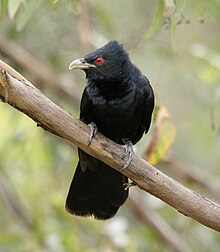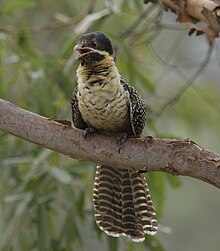Eudynamys orientalis
| Pacific koel | |
|---|---|
 |
|
 |
|
| male above, female below | |
| Scientific classification | |
| Kingdom: | Animalia |
| Phylum: | Chordata |
| Class: | Aves |
| Order: | Cuculiformes |
| Family: | Cuculidae |
| Genus: | Eudynamys |
| Species: | E. orientalis |
| Binomial name | |
|
Eudynamys orientalis (Linnaeus, 1766) |
|
 |
|
| Distribution of the Pacific koel in turquoise (also outside the map in southeast Australia) | |
The Pacific koel (Eudynamys orientalis), also known as the eastern koel, is a species of cuckoo in the Cuculidae family. In Australia, it is colloquially known as the rainbird or stormbird, as its call is usually more prevalent before or during stormy weather.
It has often been considered conspecific with the Asian and black-billed koels, but they are increasingly treated as a separate species. Alternatively, the population breeding in Australia has been considered a separate species, the Australian Koel (Eudynamys cyanocephalus), with the remaining taxa then considered subspecies of the Asian koel.
The Pacific koel is found in forest, woodland, plantations and gardens from Wallacea east to the Solomon Islands and south to northern and eastern Australia. The Pacific koel has not been rated by IUCN, but the Australian Koel (here included in the Pacific koel) is considered to be of Least Concern.
The Pacific koel is a brood parasite. In Australia, their hosts are mainly large honeyeaters (especially noisy friarbirds and red wattlebirds). Unlike in other parasitic cuckoos, the young do not attempt to kill the host chicks. This trait is shared with the channel-billed cuckoo, which – as in the Pacific koel – are largely frugivorous as adults. A study of vocalization noted that the duetting behaviour may indicate the possibility of short-term pair-bonding in its otherwise polygynous mating system.
Female, then male feeding on fruit in south-east Queensland, Australia
...
Wikipedia

